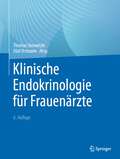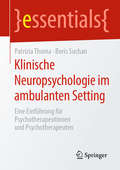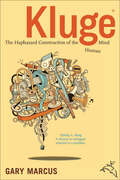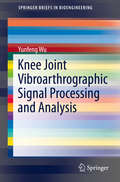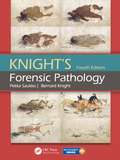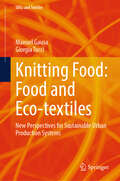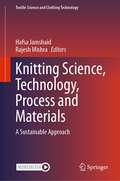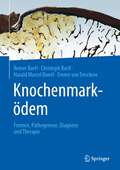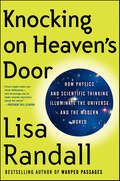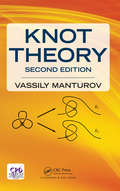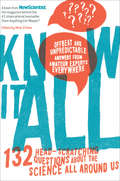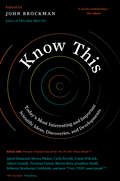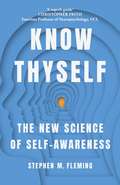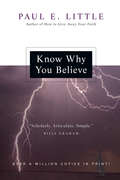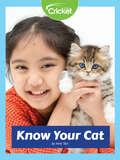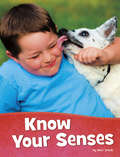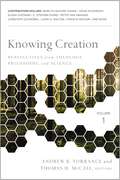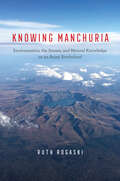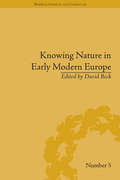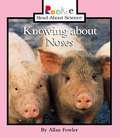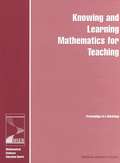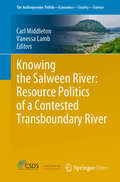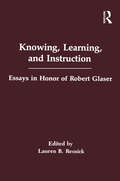- Table View
- List View
Klinische Endokrinologie für Frauenärzte
by Thomas Strowitzki Olaf OrtmannIn der 6. Auflage grundlegend und umfassend neu konzipiert, systematisch und bedarfsorientiert aufbereitet, ist das Standardwerk an die Herausforderungen in der modernen gynäkologischen Endokrinologie angepasst und voll wertvollen Wissens.Es vermittelt gynäkologisch tätigen Ärztinnen und Ärzten wichtige Grundlagen sowie spezialisiertes medizinisches Fachwissen für die optimale Behandlung ihrer Patientinnen.Darstellung aller relevanten Aspekte der gynäkologischen Endokrinologie für die Umsetzung der Theorie in die PraxisRatschläge zu innovativen BehandlungsansätzenBerücksichtigung nationaler und internationaler LeitlinienZusammenstellung wichtiger Literatur auf dem neuesten wissenschaftlichen StandHilfreiche Tipps für die Beratung der Patientin
Klinische Neuropsychologie im ambulanten Setting: Eine Einführung für Psychotherapeutinnen und Psychotherapeuten (essentials)
by Patrizia Thoma Boris SuchanDas vorliegende essential gibt einen Kurzüberblick über die Möglichkeiten und Grenzen neuropsychologischer Therapie. Das Hauptaugenmerk liegt dabei auf der ambulanten Praxis. Patienten mit erworbenen Hirnschädigungen können von einer neuropsychologischen Behandlung profitieren, wenn bei ihnen seit dem Schädigungsereignis Einschränkungen in den Bereichen Lernen und Gedächtnis, Aufmerksamkeit, Funktionen der höheren Handlungsplanung sowie Emotionalität und Gefühlsleben vorliegen.
Kluge: The Haphazard Construction of the Human Mind
by Gary MarcusPsychology professor Gary Marcus explores how evolution has affected—and altered—the functioning of the human brain in Kluge. A New York Times Book Review Editors’ ChoiceHow is it that we can recognize photos from our high school yearbook decades later, but cannot remember what we ate for breakfast yesterday? And why are we inclined to buy more cans of soup if the sign says Limit 12 Per Customer rather than Limit 4 Per Customer? In Kluge, psychology professor Gary Marcus argues convincingly that our minds are not as elegantly designed as we may believe. The imperfections result from a haphazard evolutionary process that often proceeds by piling new systems on top of old ones—and those systems don’t always work well together. The end product is a "kluge," a clumsy, cobbled-together contraption. Taking us on a tour of the essential areas of human experience—memory, belief, decision making, language, and happiness—Marcus unveils a fundamentally new way of looking at the evolution of the human mind and simultaneously sheds light on some of the most mysterious aspects of human nature.“Informative and engaging.” —New York Times–bestselling author Steven Pinker “Invigorating fun . . . one of those unexpected analogies that helps us look at everything afresh.” —New York Times Book Review“[A] fresh evolutionary perspective.” —New Scientist
Knee Joint Vibroarthrographic Signal Processing and Analysis
by Yunfeng WuThis book presents the cutting-edge technologies of knee joint vibroarthrographic signal analysis for the screening and detection of knee joint injuries. It describes a number of effective computer-aided methods for analysis of the nonlinear and nonstationary biomedical signals generated by complex physiological mechanics. This book also introduces several popular machine learning and pattern recognition algorithms for biomedical signal classifications. The book is well-suited for all researchers looking to better understand knee joint biomechanics and the advanced technology for vibration arthrometry. Dr. Yunfeng Wu is an Associate Professor at the School of Information Science and Technology, Xiamen University, Xiamen, Fujian, China.
Knight's Forensic Pathology
by Bernard Knight Pekka SaukkoThe fourth edition of Knight's Forensic Pathology continues to be the definitive international resource for those in training and in practice, covering all aspects of the medico-legal autopsy, including the cause and time of death, interpretation of wounds and every other facet of the investigation of a fatality.The contents are intended to lead th
Knitting Food: New Perspectives for Sustainable Urban Production Systems (SDGs and Textiles)
by Manuel Gausa Giorgia TucciThis book focuses on the emerging field of food waste-based eco-textiles. Eco-textiles, eco-leathers and bio-skins are now an important category of biomaterials with immediate applications in sustainable industrial production and the circular economy. In this sense, the book brings together new collaborative and interdisciplinary projects and artistic crossovers specialised in eco-textile research, (re)design and functional use of organic and food waste, in a vision that starts from the product dimension and reaches the urban scale.
Knitting Science, Technology, Process and Materials: A Sustainable Approach (Textile Science and Clothing Technology)
by Hafsa Jamshaid Rajesh MishraThis volume explains knitting technology in an easily-comprehensible and user-friendly manner. The manufacturing of a cost-effective quality product requires careful planning and thorough knowledge of the product as well as production technology. To achieve the desired functional properties in fabric, the relationship between the raw materials, process and finished product is very important. Knitting has been and remains an important textile technique due to the properties of knitted fabric such as elasticity, stretchability, and comfort. Despite the prominence of knitwear, there has been limited data regarding mechanics of weft knitted fabric and effect of structures on physical, mechanical and comfort properties. This book is an attempt to fill that gap. The book provides knowledge about fabric manufacturing techniques, weft knitting structure, and methods of evaluating knitted fabrics and their applications in technical textiles. It also discusses different types of yarn and their manufacturing processes. Testing and quality control in industrial practice as well as management of a fabric dyeing house are also covered.
Knochenmarködem: Formen, Pathogenese, Diagnose und Therapie
by Reiner Bartl Christoph Bartl Harald Marcel Bonél Emmo von TresckowHeute kann die Diagnose eines Knochenmarködems (KMÖ) nicht mehr als eine „gutartige, selbstlimitierende Erkrankung“ eingestuft werden. Vielmehr wird das KMÖ-Syndrom als Warnsignal für den möglichen Übergang in langwierige, schmerzhafte Erkrankungen (z.B. CRPS) oder gar in eine Osteonekrose mit der Konsequenz einer endoprothetischen Versorgung angesehen. Einer klinisch/radiologisch orientierten Klassifikation des lokalen KMÖ mittels MRT kommt daher besondere prognostische Bedeutung zu. Während früher eine Anbohrung des ödematösen Bezirkes als „Mittel der Wahl“ galt, stehen heute effektive Medikamente, biophysikalische Verfahren und Kombinationstherapien zur Verfügung, die zu einer Ausheilung des Ödems und auch der zugrundeliegenden Erkrankung führen.Die vier Autoren des Buches Knochenmarködem haben bei der Abhandlung der klinischen Fächer, die mit der Diagnose und Therapie eines KMÖs konfrontiert sind, großen Wert auf eine multidisziplinäre Betrachtung gelegt. Beteiligte Fachdisziplinen wie Innere Medizin, Hämatologie und Onkologie, Osteologie, Orthopädie, Traumatologie und Sportmedizin sowie Radiologie und Pharmakologie werden fachkundig abgedeckt.
Knock on Wood: Nature as Commodity in Douglas-Fir Country
by W. Scott PrudhamScott Prudham investigates a region that has in recent years seen more environmental conflict than perhaps anywhere else in the country--the old-growth forests of the Pacific Northwest. Prudham employs a political economic approach to explain the social and economic conflicts arising from the timber industry's presence in the region. As well, he provides a thorough accounting of the timber industry itself, tracing its motivations, practices, and labor relations.
Knocking on Heaven's Door: How Physics and Scientific Thinking Illuminate the Universe and the Modern World
by Lisa Randall“Science has a battle for hearts and minds on its hands….How good it feels to have Lisa Randall’s unusual blend of top flight science, clarity, and charm on our side.”—Richard Dawkins“Dazzling ideas….Read this book today to understand the science of tomorrow.”—Steven PinkerThe bestselling author of Warped Passages, one of Time magazine’s “100 Most Influential People in the World,” and one of Esquire’s “75 Most Influential People of the 21st Century,” Lisa Randall gives us an exhilarating overview of the latest ideas in physics and offers a rousing defense of the role of science in our lives. Featuring fascinating insights into our scientific future born from the author’s provocative conversations with Nate Silver, David Chang, and Scott Derrickson, Knocking on Heaven’s Door is eminently readable, one of the most important popular science books of this or any year. It is a necessary volume for all who admire the work of Stephen Hawking, Michio Kaku, Brian Greene, Simon Singh, and Carl Sagan; for anyone curious about the workings and aims of the Large Hadron Collider, the biggest and most expensive machine ever built by mankind; for those who firmly believe in the importance of science and rational thought; and for anyone interested in how the Universe began…and how it might ultimately end.
Knot Theory: Second Edition
by Vassily Olegovich ManturovOver the last fifteen years, the face of knot theory has changed due to various new theories and invariants coming from physics, topology, combinatorics and alge-bra. It suffices to mention the great progress in knot homology theory (Khovanov homology and Ozsvath-Szabo Heegaard-Floer homology), the A-polynomial which give rise to strong invariants of knots and 3-manifolds, in particular, many new unknot detectors. New to this Edition is a discussion of Heegaard-Floer homology theory and A-polynomial of classical links, as well as updates throughout the text.<P><P> Knot Theory, Second Edition is notable not only for its expert presentation of knot theory’s state of the art but also for its accessibility. It is valuable as a profes-sional reference and will serve equally well as a text for a course on knot theory.
Know It All: 132 Head-Scratching Questions About the Science All Around Us
by NewScientistSome of the craziest questions & answers from the magazine’s “Last Word” column, on subjects like Earth, space, meteorology, evolution, health, and more.New Scientist magazine’s beloved “Last Word” column is a rare forum for “un-Google-able” queries: Readers write in, and readers respond! Know It All collects 132 of the column’s very best Q&As. The often-wacky questions cover physics, chemistry, zoology and beyond: When will Mount Everest cease to be the tallest mountain on the planet? If a thermometer was in space, what would it read? Why do some oranges have seeds, and some not? Many people suffer some kind of back pain. Is it because humans haven’t yet perfected the art of walking upright? And the unpredictable answers showcase the brainpower of New Scientist’s readers, like the anatomist who chimes in about back pain (“Evolution is not in the business of perfecting anything.”) and the vet who responds, “Quadrupeds can get backache too!”A Guardian Top 10 Science and Technology bookPraise for Know It All“An entertaining and intellectually stimulating read.” —Shelf Awareness“The experts at New Scientist magazine have published a book that answers some of the oddest but most entertaining questions they’ve been asked.” —Daily Mail (UK)“Explain[s] some of life’s great mysteries.” —Reveal (UK)“Answers the questions you’ve probably wondered all your life.” —Wales Online (UK)“Great answers to common dinner party questions.” —Good Housekeeping (UK)
Know This: Today's Most Interesting and Important Scientific Ideas, Discoveries, and Developments
by Mr John BrockmanToday's most visionary thinkers reveal the cutting-edge scientific ideas and breakthroughs you must understand.Scientific developments radically change and enlighten our understanding of the world -- whether it's advances in technology and medical research or the latest revelations of neuroscience, psychology, physics, economics, anthropology, climatology, or genetics. And yet amid the flood of information today, it's often difficult to recognize the truly revolutionary ideas that will have lasting impact. In the spirit of identifying the most significant new theories and discoveries, John Brockman, publisher of Edge.org ("The world's smartest website" -- The Guardian), asked 198 of the finest minds What do you consider the most interesting recent scientific news? What makes it important?Pulitzer Prize-winning author of Guns, Germs, and Steel Jared Diamond on the best way to understand complex problems * author of Seven Brief Lessons on Physics Carlo Rovelli on the mystery of black holes * Harvard psychologist Steven Pinker on the quantification of human progress * TED Talks curator Chris J. Anderson on the growth of the global brain * Harvard cosmologist Lisa Randall on the true measure of breakthrough discoveries * Nobel Prize-winning physicist Frank Wilczek on why the twenty-first century will be shaped by our mastery of the laws of matter * philosopher Rebecca Newberger Goldstein on the underestimation of female genius * music legend Peter Gabriel on tearing down the barriers between imagination and reality * Princeton physicist Freeman Dyson on the surprising ability of small (and cheap) upstarts to compete with billion-dollar projects. Plus Nobel laureate John C. Mather, Sun Microsystems cofounder Bill Joy, Wired founding editor Kevin Kelly, psychologist Alison Gopnik, Genome author Matt Ridley, Harvard geneticist George Church, Why Does the World Exist? author Jim Holt, anthropologist Helen Fisher, and more.
Know Thyself: The New Science of Self-Awareness
by Stephen M FlemingFrom the ancient Greeks to Buddhism, our ability to check reality and recalibrate has fascinated philosophers for thousands of years. Yet it is only recently that we've developed the technology to create a rigorous science of self-awareness, what we call metacognition.Head of the Metacognition Lab at University College London, Stephen Fleming is the world's leading expert in this new field of neuroscience. In Know Thyself he explains both the vast potential of metacognition and why it is that we still so often get it wrong. Based on his own pioneering studies, full of cutting-edge research from computer science, psychology and evolutionary biology, made tangible with powerful real-life examples, Dr Fleming shows how developing metacognition can help us become smarter, make better decisions and lead more effectively.While AI has been posted as the remedy to human error, its flaw is its lack of self-awareness. In the way a coach can dramatically improve an athlete's performance or a conductor can guide an orchestra through a complicated piece of music, Know Thyself reveals how metacognition offers humanity a crucial edge in our modern world. It is one that might yet turn out to be our saving grace.
Know Why You Believe: A Clear Affirmation For The Reasonableness Of The Christian Faith (Know What/why Ser.)
by Paul E. LittleChristianity TodayKnow Why You Believe
Know Your Cat
by Amy TaoCats are amazing creatures! They have a lot of senses that make the way they see, hear, and smell very different from humans. Do you know the differences between cat and human senses?
Know Your Senses (Health and My Body)
by Mari SchuhYour five senses help make every day complete. From smelling and tasting breakfast to feeling soft sheets when you climb into bed, your senses play a big part in your life. Descriptive text and energetic photos highlight the importance of taste, touch, sight, smell, and hearing. Know Your Senses includes a glossary, a read more section, kid-friendly Internet sites, and an index.
Knowing Creation: Perspectives from Theology, Philosophy, and Science
by Thomas H. McCall Andrew B. TorranceIt is hard to think of an area of Christian theology that provides more scope for interdisciplinary conversation than the doctrine of creation. This doctrine not only invites reflection on an intellectual concept: it calls for contemplation of the endlessly complex, dynamic, and fascinating world that human being inhabit. But the possibilities for wide-ranging discussion are such that scholars sometimes end up talking past one another. Productive conversation requires mutual understanding of insights across disciplinary boundaries. Knowing Creation offers an essential resource for helping scholars from a range of fields to appreciate one another's concerns and perspectives. In so doing, it offers an important step forward in establishing a mutually-enriching dialogue that addresses, amongst others, the following key questions:Who is the God who creates?Why does God create?What is "creation"?What does it mean to recognize that a theology of creation speaks of a natural world that is subject to the observation of the natural sciences? What does it mean to talk about both a "natural" order and a "created" order?What are the major tensions that have arisen between the natural sciences and Christian thinking historically, and why? How can we move beyond such tensions to a positive and constructive conversation, while also avoiding facile notions such as a "god of the gaps"?Is it feasible for a natural scientist to maintain a belief in God's continuing creative activity?In what ways might a naturalistic understanding of the natural world be said to be limited?How can biblical studies, theology, philosophy, history, and science talk better together about these questions?At a time when the doctrine of creation - and even a mention of "creation" - has been disparaged due to its supposed associations with anti-scientific dogma, and theological offerings sometimes risk appearing a little more than reactionary exercises in naive apologetics, ill-informed by science or distinctly wary of engagement with it, it is more important than ever to offer a cross-disciplinary resource that can voice a positive account of a Christian theology of creation, and do so as a genuinely broad-ranging conversation about science and faith.Contributors to Knowing Creation include Marilyn McCord Adams, Denis Alexander, Susan Eastman, C. Stephen Evans, Peter van Inwagen, Christoph Schwobel, John H. Walton, Francis Watson, and more.X
Knowing Manchuria: Environments, the Senses, and Natural Knowledge on an Asian Borderland
by Ruth RogaskiMaking sense of nature in one of the world’s most contested borderlands. According to Chinese government reports, hundreds of plague-infected rodents fell from the skies over Gannan county on an April night in 1952. Chinese scientists determined that these flying voles were not native to the region, but were vectors of germ warfare, dispatched over the border by agents of imperialism. Mastery of biology had become a way to claim political mastery over a remote frontier. Beginning with this bizarre incident from the Korean War, Knowing Manchuria places the creation of knowledge about nature at the center of our understanding of a little-known but historically important Asian landscape. At the intersection of China, Russia, Korea, and Mongolia, Manchuria is known as a site of war and environmental extremes, where projects of political control intersected with projects designed to make sense of Manchuria’s multiple environments. Covering more than 500,000 square miles, Manchuria’s landscapes include temperate rainforests, deserts, prairies, cultivated plains, wetlands, and Siberian taiga. With analysis spanning the seventeenth century to the present day, Ruth Rogaski reveals how an array of historical actors—Chinese poets, Manchu shamans, Russian botanists, Korean mathematicians, Japanese bacteriologists, American paleontologists, and indigenous hunters—made sense of the Manchurian frontier. She uncovers how natural knowledge, and thus the nature of Manchuria itself, changed over time, from a sacred “land where the dragon arose” to a global epicenter of contagious disease; from a tragic “wasteland” to an abundant granary that nurtured the hope of a nation.
Knowing Manchuria: Environments, the Senses, and Natural Knowledge on an Asian Borderland
by Ruth RogaskiMaking sense of nature in one of the world’s most contested borderlands. According to Chinese government reports, hundreds of plague-infected rodents fell from the skies over Gannan county on an April night in 1952. Chinese scientists determined that these flying voles were not native to the region, but were vectors of germ warfare, dispatched over the border by agents of imperialism. Mastery of biology had become a way to claim political mastery over a remote frontier. Beginning with this bizarre incident from the Korean War, Knowing Manchuria places the creation of knowledge about nature at the center of our understanding of a little-known but historically important Asian landscape. At the intersection of China, Russia, Korea, and Mongolia, Manchuria is known as a site of war and environmental extremes, where projects of political control intersected with projects designed to make sense of Manchuria’s multiple environments. Covering more than 500,000 square miles, Manchuria’s landscapes include temperate rainforests, deserts, prairies, cultivated plains, wetlands, and Siberian taiga. With analysis spanning the seventeenth century to the present day, Ruth Rogaski reveals how an array of historical actors—Chinese poets, Manchu shamans, Russian botanists, Korean mathematicians, Japanese bacteriologists, American paleontologists, and indigenous hunters—made sense of the Manchurian frontier. She uncovers how natural knowledge, and thus the nature of Manchuria itself, changed over time, from a sacred “land where the dragon arose” to a global epicenter of contagious disease; from a tragic “wasteland” to an abundant granary that nurtured the hope of a nation.
Knowing Nature in Early Modern Europe (Warwick Series in the Humanities #5)
by David BeckToday we are used to clear divisions between science and the arts. But early modern thinkers had no such distinctions, with ‘knowledge’ being a truly interdisciplinary pursuit. Each chapter of this collection presents a case study from a different area of knowledge.
Knowing about Noses
by Allan FowlerFrom friendly dolphins to giant pandas, from icebergs and glaciers to energy from the sun, from magnets to solids, liquids, and gases, Rookie Read-About Science is a natural addition to the primary-grade classroom with books that cover every part of the science curricula. Includes: animals, nature, scientific principles, the environment, weather, and much more!
Knowing and Learning Mathematics for Teaching
by Mathematics Teacher Preparation Content Workshop Program Steering CommitteeThere are many questions about the mathematical preparation teachers need. Recent recommendations from a variety of sources state that reforming teacher preparation in postsecondary institutions is central in providing quality mathematics education to all students. The Mathematics Teacher Preparation Content Workshop examined this problem by considering two central questions: What is the mathematical knowledge teachers need to know in order to teach well? How can teachers develop the mathematical knowledge they need to teach well? The Workshop activities focused on using actual acts of teaching such as examining student work, designing tasks, or posing questions, as a medium for teacher learning. The Workshop proceedings, Knowing and Learning Mathematics for Teaching, is a collection of the papers presented, the activities, and plenary sessions that took place.
Knowing the Salween River: Resource Politics of a Contested Transboundary River (The Anthropocene: Politik—Economics—Society—Science #27)
by Carl Middleton Vanessa LambThis open access book focuses on the Salween River, shared by China, Myanmar, and Thailand, that is increasingly at the heart of pressing regional development debates. The basin supports the livelihoods of over 10 million people, and within it there is great socio-economic, cultural and political diversity. The basin is witnessing intensifying dynamics of resource extraction, alongside large dam construction, conservation and development intervention, that is unfolding within a complex terrain of local, national and transnational governance. With a focus on the contested politics of water and associated resources in the Salween basin, this book offers a collection of empirical case studies that highlights local knowledge and perspectives. Given the paucity of grounded social science studies in this contested basin, this book provides conceptual insights at the intersection of resource governance, development, and politics of knowledge relevant to researchers, policy-makers and practitioners at a time when rapid change is underway.- Fills a significant knowledge gap on a major river in Southeast Asia, with empirical and conceptual contributions- Inter-disciplinary perspective and by a range of writers, including academics, policy-makers and civil society researchers, the majority from within Southeast Asia- New policy insights on a river at the cross-roads of a major political and development transition
Knowing, Learning, and instruction: Essays in Honor of Robert Glaser (Psychology of Education and Instruction Series)
by Lauren B. ResnickCelebrating the 20th anniversary of the Learning Research and Development Center (LRDC) at the University of Pittsburgh, these papers present the most current and innovative research on cognition and instruction. Knowing, Learning, and Instruction pays homage to Robert Glaser, founder of the LRDC, and includes debates and discussions about issues of fundamental importance to the cognitive science of instruction.
